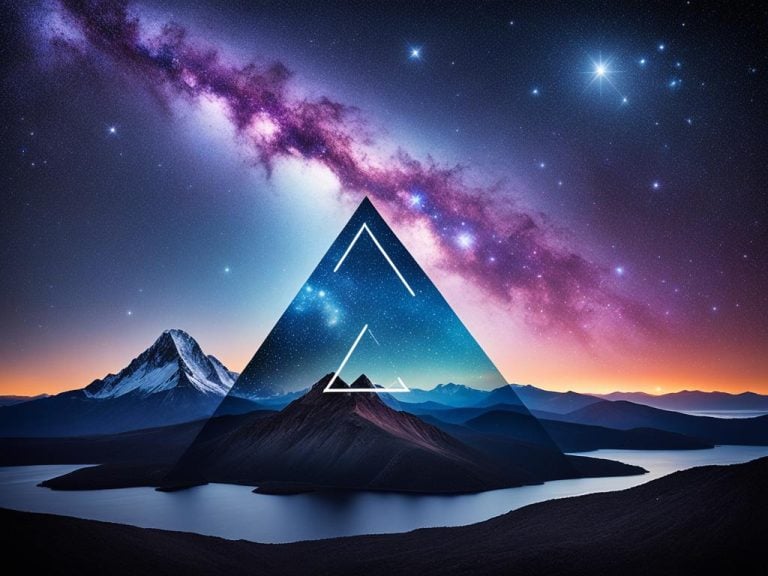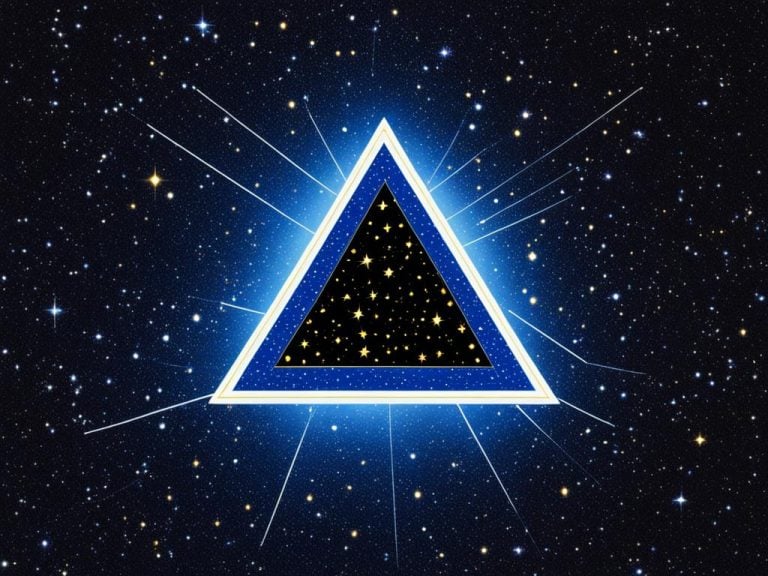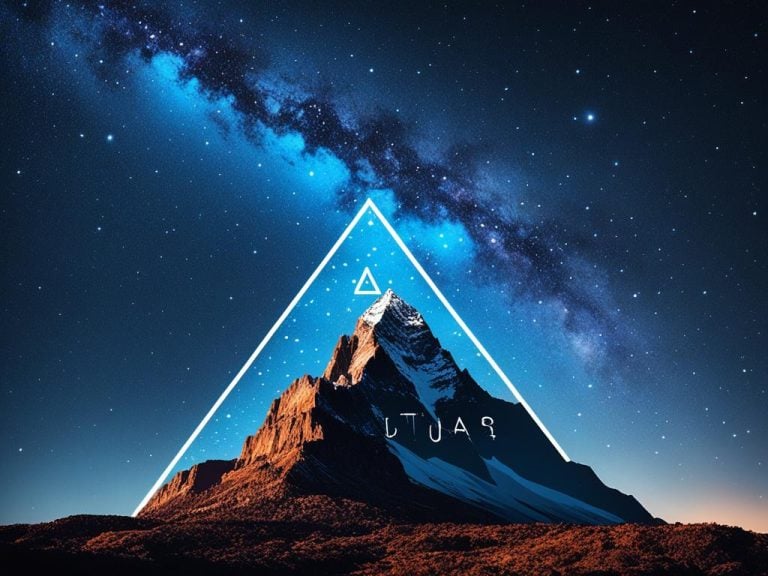Discover Triangulum Australe Constellation Secrets
Did you know that Triangulum Australe is a small and often overlooked constellation? It shines brightly in the southern skies. Despite its size, it has an amazing past and mythology that goes back centuries.
Indigenous Australian cultures and Dutch navigators found it fascinating. It has left a powerful mark on our knowledge of the stars. This celestial wonder is truly mesmerizing.
Are you someone who loves to learn about stars, myths, or the night sky’s mysteries? Then, Triangulum Australe is perfect for you. It’s filled with bright stars and deep sky treasures. This constellation is like a hidden gem just waiting to be discovered.

Key Takeaways:
- Triangulum Australe is a small constellation located in the southern skies.
- It holds a rich history and mythology, capturing the imagination of indigenous cultures and early navigators.
- Exploring Triangulum Australe can offer insights into astronomy, mythology, and our place in the universe.
- Naming a star in Triangulum Australe can be a unique and heartfelt gift for any occasion.
- Unveil the secrets of Triangulum Australe and discover the wonders of the southern hemisphere’s night sky.
Unveiling the Mysteries of Triangulum Australe
The Triangulum Australe Constellation is known as the Southern Triangle. It is a stunning group of stars. Three bright stars mark its corners: Alpha Trianguli Australis, Beta Trianguli Australis, and Gamma Trianguli Australis.
Alpha Trianguli Australis, or Atria, shines the brightest. It’s easy to see with just your eyes. Beta Trianguli Australis, called Circinus, is significant too. Gamma Trianguli Australis is a bit dimmer. But it helps make the triangle shape clear.
Yet, the constellation has more than its famous triangle. It contains many deep sky wonders. These include clusters, nebulae, and galaxies.
The Triangulum Galaxy is especially stunning. Also known as Messier 33, it is nearby. This galaxy is a beautiful sight in the constellation’s sky.
Studying Triangulum Australe lets us see the universe’s vastness. We learn about its wonders. The constellation’s stars, shapes, and deep sky treasures always amaze and inspire us.
History and Mythology of Triangulum Australe
Triangulum Australe is the Southern Triangle in the sky. It has a rich history and myths. People from many cultures, ancient and native, treasure this constellation.
In Australia, it guided navigation and was spiritually important. The stars helped people understand the cosmos. It was key to their spiritual and practical lives.
Greek and Roman stories connected the constellation to a divine birthplace. It symbolized the island of Delos, where Apollo and Artemis were born. This linked the triangle to a famous myth.
The constellation became known in Europe in the 16th century. Dutch explorers first wrote about it. Later, it was named an official constellation in European astronomy.
Triangulum Australe in Indigenous Cultures
Indigenous Australians see the night sky as very important. Triangulum Australe, with its unique shape, helped in daily and spiritual life. It guided journeys and was a spiritual aid.
The Influence of Greek and Roman Mythology
Greek and Roman myths add to the constellation’s meaning. They tell of Apollo and Artemis’s birth at Delos. This makes the triangle symbolize powerful myths.
Knowing the history and myths makes the constellation special. It shows how stars connect with human culture. They are more than just natural sights.
- Triangulum Australe has a rich history and mythological significance.
- Indigenous Australian cultures attributed spiritual and navigational significance to this constellation.
- Greek and Roman mythology connected Triangulum Australe to the birthplace of Apollo and Artemis.
- Dutch navigators cataloged the constellation in the 16th century, establishing its recognition in European astronomy.
Naming Your Own Star in Triangulum Australe
Want to make a special memory or give a unique present? International Star Registry lets you name a star after someone in Triangulum Australe. By doing this, you can make your love, joy, or special memories last forever in the night sky.
Naming your star gets you a special certificate. It shows your star’s exact position so you can find it in the sky. This certificate is a lasting sign of your love and can be shown with pride.
You can make your star gift even more special. Add a message for a birthday, anniversary, or another big moment. This makes your gift more personal and meaningful.
Want to explore more than just Triangulum Australe? You can also buy a star for someone in the Ara constellation. It’s in the south and offers another great way to make special memories.
Visit these links to learn more about Triangulum Australe, Ara, and the Triangulum constellation: Ara, and Triangulum constellation.

Naming a star in Triangulum Australe or Ara is a touching way to mark life’s big moments. It’s perfect for a loved one or as a special treat for yourself. It’s a gift that keeps on shining, generation after generation.
Why Name a Star?
Symbols are powerful, especially for showing how we feel and marking special times. Naming a star in the Triangulum Australe constellation is more than a gesture. It stands for love, memories, and gratitude. It’s a perfect way to honor someone special, celebrate a big event, or remember those we’ve lost.
Naming a star makes a unique link to the night sky. Each glance upwards will remind you of why that star is special. This beautiful gift connects the vast universe with your deepest feelings.
This naming adds to your legacy and helps explore the universe for future generations. It’s a gift that mixes personal emotions with a broader, meaningful impact.
Want to know more about the Triangulum Australe and its stars? Visit places like Wikipedia and Constellation Guide. Let your interest take you to the wonders of the sky.
How to View Triangulum Australe in the Southern Hemisphere
Triangulum Australe, known as the Southern Triangle, is a beautiful constellation in the southern sky. Here’s how to see it:
- Pick the Winter Months: It’s best to see Triangulum Australe in winter. This is when the stars are high up in the sky.
- Find a Dark Spot: To see the constellation clearly, go where it’s dark. City lights can make it hard to see the stars.
- Look for Orion’s Belt: Orion is a bright constellation you can see in winter. Find the three stars that make up Orion’s Belt.
- Use Orion’s Belt as a Guide: Draw an imaginary line from Orion’s Belt to the south-southeast. You’ll find Triangulum Australe in that direction.
- Admire the Shape: Look at the triangular figure of Triangulum Australe. Atria, Betria, and Gatria are its three main stars.
Remember, you might not always see Triangulum Australe clearly. It depends on the weather and how much light is around. For the best view, make sure the southern horizon is clear of obstruction. Then, enjoy the night sky’s beauty.
Explore the Enchanting Southern Skies
The southern hemisphere has more than just Triangulum Australe to offer. It’s filled with stars and wonders. Don’t miss exploring the Southern Cross, the Magellanic Clouds, and other amazing sights in the night sky.
Mythology of the Triangulum Australe Constellation
In Greek mythology, the Triangulum Australe is special. It’s linked to the Nile river delta and Sicily. The ancient Greeks saw it as the Nile delta, a place rich with crops and wealth.
On the other hand, Greeks linked it to Sicily too. Sicily was known for its beauty and culture. The constellation honored this area in the night sky.
The Babylonians called it the Plough. They saw it as a plough in the sky. It’s a nod to farming and life on earth.
The myths make the Triangulum Australe more than just stars. They are threads connecting the sky to our stories. And they keep us looking up, amazed.
The Triangulum Australe hides stories in its stars. These tales mix its beauty with history and myth. Let’s learn more about the stars and secrets it holds.
Prominent Stars in the Triangulum Australe Constellation
The Triangulum Australe constellation has many bright stars that catch the eye. Beta Trianguli, Alpha Trianguli, and Gamma Trianguli are especially dazzling.
Beta Trianguli stands out as the “South Star” for being the most brilliant. It shines in a special bluish-white light that makes the night sky magical.
Next is Alpha Trianguli, also a shining beauty. This star glows in a lovely golden color. It makes the whole southern sky stunning to look at.
Gamma Trianguli is a bit fainter but still beautiful. It has a soft light and lies close to the other stars. This closeness makes it a key player in the constellation.
Beta Trianguli, Alpha Trianguli, and Gamma Trianguli are important stars here. Although they’re not the brightest, they hold a special place in the constellation’s heart.
Deep Sky Objects in Triangulum Australe
The Triangulum Australe constellation is famous for its bright stars and deep sky objects. The Triangulum Galaxy (Messier 33) stands out. It’s a spiral galaxy you can see without a telescope. It’s also one of the farthest things we can see, at 3 million light-years away.
In Triangulum Australe, you’ll find more than just the Triangulum Galaxy. There’s NGC 6025, an open star cluster of young stars. They all came from the same gas cloud. You’ll also spot NGC 5979, which is a planetary nebula formed by a dying star. This nebula glows softly in the night sky.
Other cool objects in this area include NGC 6027, IC 469, NGC 5949, and NGC 6028. NGC 6027 is a barred spiral galaxy, while IC 469 and NGC 5949 are regular galaxies. Lastly, NGC 6028 adds to the variety as another spiral galaxy. Looking at these objects can show us the beauty and variety of space.
Interested in learning more about the Triangulum Australe’s deep sky objects? Visit websites like theskylive.com, seasky.org, and deepskyphotography.co.uk. They’re great places for stargazers and those who love astronomy.
Exploring Triangulum Australe’s Deep Sky Objects:
- Triangulum Galaxy (Messier 33)
- NGC 6025 (Open Star Cluster)
- NGC 5979 (Planetary Nebula)
- NGC 6027 (Barred Spiral Galaxy)
- IC 469 (Galaxy)
- NGC 5949 (Galaxy)
- NGC 6028 (Spiral Galaxy)
Fun Facts and Details about Triangulum Australe
Triangulum Australe, also known as the Southern Triangle, is in the southern sky. It’s an intriguing constellation. We will look into some fascinating facts and details about it.
Constellation Size
It is the 78th largest constellation, covering about 132 square degrees. Its shape is a perfect triangle. It’s a joy to look at.
Greek Catalog
The ancient Greeks recorded Triangulum Australe. It has a unique Latin name meaning “southern triangle.” This name reflects its special shape.
Genitive Form
Its genitive form is “Trianguli Australis.” This shows ownership. It’s used in naming connections between constellations and their stars.
Neighboring Constellations
It lives near other beautiful constellations. You can see the amazing Andromeda, Aries, Perseus, and Pisces nearby. Together, they make a stunning image in the sky.
Meteor Showers
Triangulum Australe itself doesn’t have meteor showers. But, the constellations around it sometimes give us great meteor shows. These events light up the night sky.

Triangulum Australe – A Stellar Beauty in the Nights Sky
Triangulum Australe, though small, shines beautifully in the night. It is loved by both star lovers and scientists. Its gentle glow stands out, pulling everyone’s eyes towards it.
This constellation is not famous, but it should be. It has its own quiet beauty that can charm anyone. Its unique stars create a scene that is both simple and stunning.
Triangulum Australe is special for many reasons. People long ago saw it as a sign of adventure and exploration. It connects us to stories of the past through its stars.
Located in the Southern Hemisphere, it paints the night sky with its beauty. It may not be bright, but its charm is undeniable. Looking at it brings a sense of peace and wonder.
Exploring Triangulum Australe lets us see the sky in a new light. It’s a hidden treasure for those who love stars. Viewing it fills us with a feeling of grace and beauty.
- Size: Despite its smaller size, the Triangulum Australe Constellation carries its own cosmic allure.
- Brightness: While it may not be the brightest constellation in the night sky, Triangulum Australe enchants viewers with its modest radiance.
- Celestial Significance: The Triangulum Australe Constellation carries a profound astronomical legacy, symbolizing exploration and discovery.
A night spent looking at Triangulum Australe is a magical experience. It opens our eyes to the universe’s wonders. This constellation invites us to dream and wonder about the vast unknown.
Conclusion
Triangulum Australe is a constellation with a lot of history and stories. It has been a wonder to people who look at the stars for many years. There is so much beauty and inspiration in its secrets.
Naming a star through International Star Registry is a special thing. It makes a unique and lasting gift for any occasion. It shows love, devotion, and a strong bond with someone.
Explore the magic of Triangulum Australe. Feel the charm of its stories, see its bright stars, and enjoy the amazing objects in the sky. It’s a great way to start a journey into the night sky.
FAQ
Can I name a star in the Triangulum Australe constellation?
Yes, you can name a star there through International Star Registry.
What do I receive when I name a star in Triangulum Australe?
You get a special star certificate. It has your star’s name, where it is in the sky, and a dedication date.
How can I view the Triangulum Australe constellation?
Look for it in the winter, if you’re in the south. Orion’s belt can help you find it. You’ll need a dark place with a clear view south.
Are there any prominent stars or celestial objects in Triangulum Australe?
Yes, it has bright stars like Beta Trianguli. Also, the Triangulum Galaxy and other cool stuff can be found there.
What is the best time to view Triangulum Australe in the southern hemisphere?
Winter is the best time to see it in the south.
How can I locate the Triangulum Australe constellation?
Start by finding Orion’s belt. Use it as a guide to find Triangulum Australe.
What is the role of International Star Registry in naming a star?
They help people name stars and give them certificates. Plus, they support learning about space.
Source Links
- Stars, Myth, Facts… – Constellation Guide – https://www.constellation-guide.com/constellation-list/triangulum-constellation/
- The Triangulum Constellation: A Guide to Viewing from Ireland – https://stargazingireland.com/the-triangulum-constellation-a-guide-to-viewing-from-ireland/
